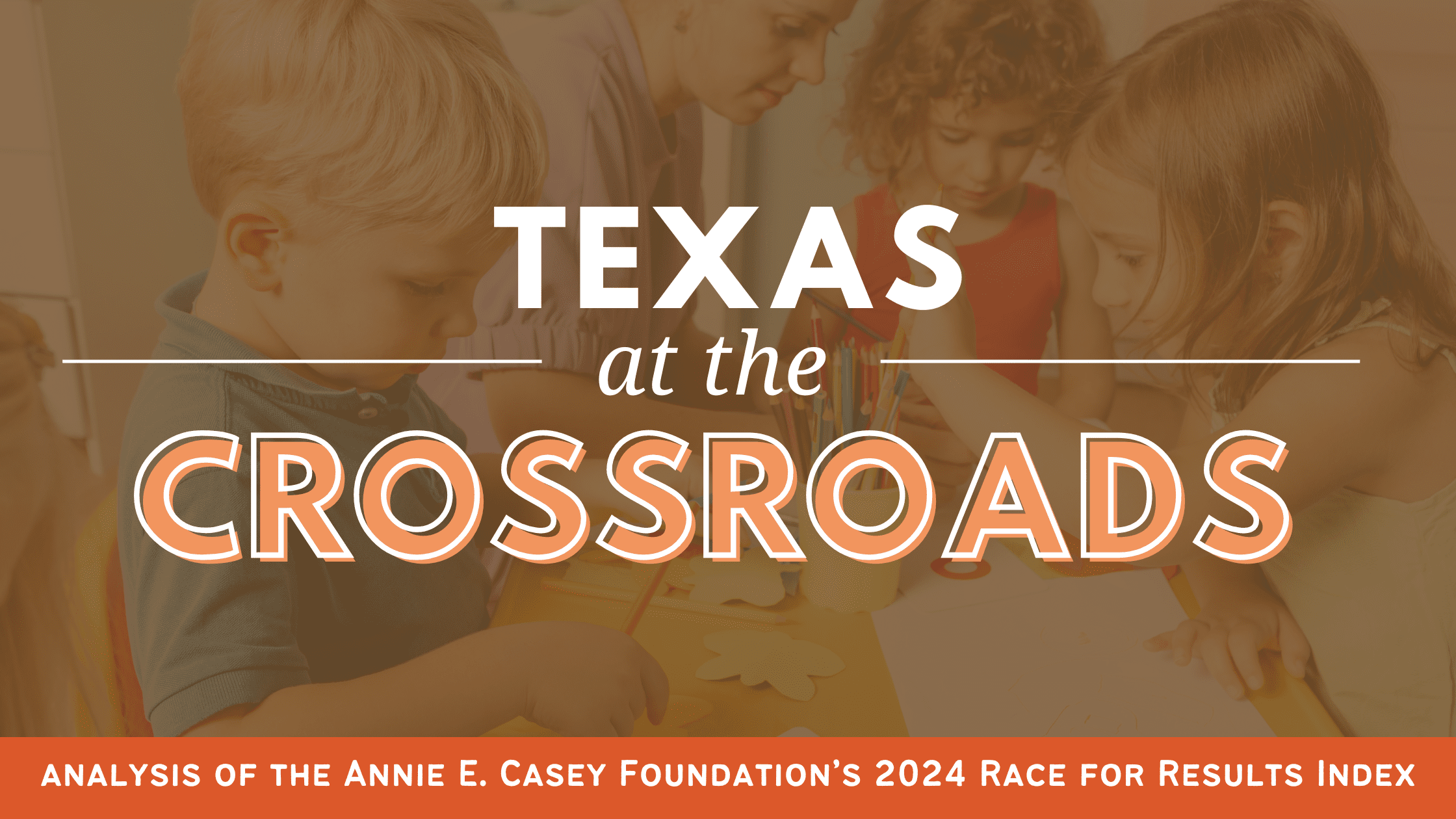Read the Race for Results Report.
A decade after the Annie E. Casey Foundation’s inaugural Race for Results report, the 2024 index offers a nuanced perspective on the progress the United States has made over time regarding children and youth well-being across racial and ethnic groups. When it comes to Texas, these data unravel the complexities and disparities within the state. Despite some improvements in overall well-being, unacceptable gaps persist and highlight the need for targeted investments and policy shifts. The data place Texas at a critical crossroads, balancing strides while grappling with persistent challenges.
A composite score (0-1,000) serves as the comprehensive measure of children’s progress on key milestones from cradle to career. The 12 indicators, standardized across racial and ethnic groups, provide a holistic view of well-being by factoring in education, health, and economic security.
The higher the index score, the greater the likelihood that children in a specific group are meeting the milestones associated with success. Ten years later, the stark reality is that no racial or ethnic group in the U.S. has come close to the maximum score, proof of the persistent challenges and disparities that demand immediate attention and targeted interventions.
National Disparities
The national scores reveal a stark contrast in well-being between Black and Asian and Pacific Islander children, at 386 and 771, respectively. State-level calculations reveal that geographical location plays a role in children’s well-being; While Asian and Pacific Islander children in New Jersey boast the highest index score of 877, American Indian or Alaska Native children in South Dakota face a distressing low of 180. Texas, as a microcosm of this national landscape, mirrors both the progress and the pitfalls.
The Texas Outlook
The 2024 data highlight the need for focused strategies that address disparities and promote equitable well-being for all children in Texas, while recognizing the unique challenges faced by each demographic group.
- Asian Pacific Islander (API) children rank sixth with a score of 807, signaling strong well-being outcomes.
- American Indian Alaskan Native (AIAN) children follow closely, ranking third with a score of 666, indicating positive results.
- Challenges persist for Black children, who rank 20th with a score of 435.
- White children also rank 20th, but with a higher outcome score of 713.
- Latina/o children rank 32nd with a score of 428, signaling a need for targeted intervention.
- Children of two or more races rank 17th with a score of 631, suggesting moderate well-being.
Demographic Landscapes are Changing
The United States
There’s been a dynamic shift within the demographic landscape of the United States, where children and youths of diverse ethnic backgrounds are now the predominant majority. This transformation is particularly visible among the 72 million children under the age of 18.

The intricate racial and ethnic mosaic of this younger demographic emphasizes the pivotal role that American Indian or Alaska Native, Asian and Pacific Islander, Black, and Latino individuals play in our communities. Recognizing their contributions is not only an acknowledgment of historical achievements, but also an essential step in dismantling systemic barriers and cultivating a culture of inclusivity.
Texas
Texas is a microcosm of this nationwide trend. Hispanic or Latino children constitute nearly half of the youth population at 49%, Black children account for 12%, white children make up 31%, while all other racial groups collectively contribute 8% to the population. These figures are proof of our state’s rich and growing diversity.
Projections indicate that the child population of Texas (17 years old and younger) will surpass 8.3 million by 2050. This anticipated growth reinforces the need to proactively address the evolving needs and aspirations of this diverse and expanding demographic. Embracing this demographic shift with a commitment to equity and inclusivity is not just a choice. It is a strategic investment in the future resilience and prosperity of the Lone Star State and, by extension, the entire nation. Explore Texas children’s well-being by county on our interactive map.
Equitable Access to Opportunity For All Texas Children
Texas is at a crossroads, navigating both progress and worsening disparities within its diverse communities. The 2024 index results call for increased, equitable action to raise opportunity for children of color. We urge leaders at local, state, and federal levels to remove long-standing barriers and ensure every young person can achieve their full potential. As the nation grapples with the mission of creating a brighter future for all, Texas serves as both a microcosm of the challenges and a potential beacon of success through targeted, data-driven interventions.
The disparities in well-being present a clear and present danger to the country’s health and economic security. The COVID-19 pandemic and its subsequent policy solutions, including the temporary expansion of the federal Child Tax Credit (CTC), are proof of what good can come when leaders follow data and evidence.
Read the Race for Results Report.
Access our Texas Kids Count Data from 2022 here.
